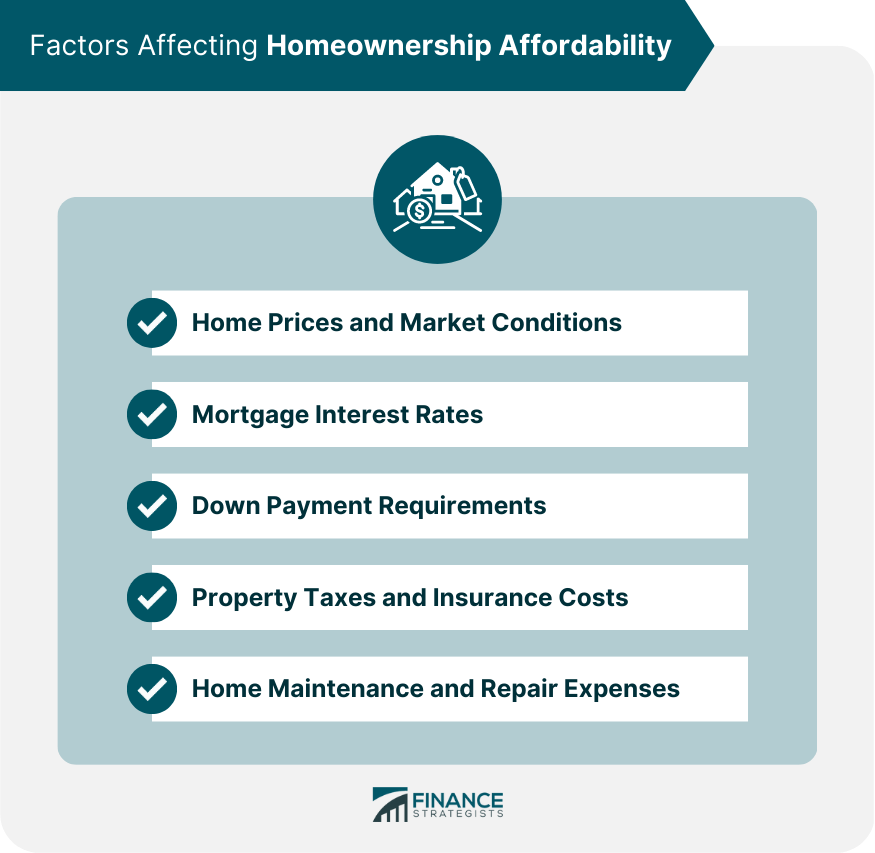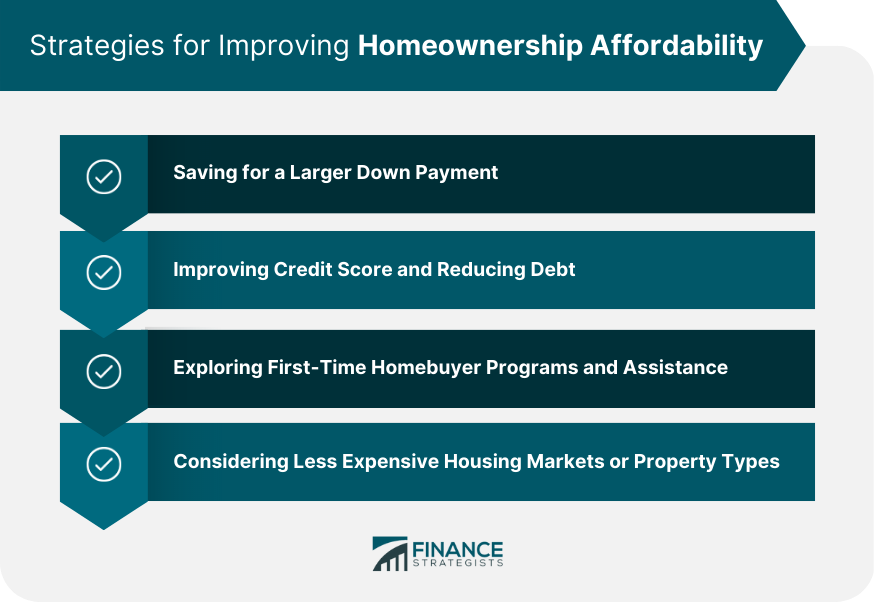A homeownership affordability analysis is the process of evaluating one's financial situation to determine the maximum amount one can afford to spend on purchasing a home while maintaining a sustainable financial future. This analysis helps potential homebuyers make informed decisions that align with their long-term financial goals. Understanding the affordability of homeownership is crucial to avoid financial strain and ensure long-term stability. Purchasing a home within one's financial means can prevent potential issues such as defaulting on mortgage payments or struggling to cover maintenance and property expenses. Current housing market conditions play a significant role in determining homeownership affordability. Factors such as supply and demand, economic trends, and regional differences can impact home prices and affect the affordability of properties in specific areas. Mortgage interest rates are a critical factor in determining the overall cost of homeownership. Lower interest rates can make purchasing a home more affordable by reducing the total amount of interest paid over the life of the loan. The down payment required to purchase a home can significantly impact affordability. A larger down payment reduces the amount of the mortgage needed, potentially leading to lower monthly payments and a more affordable home purchase. Property taxes and insurance costs should be factored into the affordability analysis, as they can impact the overall monthly housing expenses. These costs can vary depending on the location and value of the property. Owning a home comes with ongoing maintenance and repair expenses. Prospective homebuyers should account for these costs in their affordability analysis to ensure they can comfortably cover these expenses while maintaining financial stability. A stable income and job security are essential factors to consider when assessing homeownership affordability. Consistent income allows for reliable mortgage payments and reduces the risk of financial strain related to homeownership. A strong credit score and credit history can impact homeownership affordability by influencing the mortgage interest rates and loan terms available to a potential buyer. A higher credit score can lead to more favorable loan terms and lower interest rates, making homeownership more affordable. Existing debt, such as student loans or credit card balances, can affect a potential buyer's ability to afford a home. The debt-to-income (DTI) ratio is a measure of the proportion of debt to income and is often considered by lenders when evaluating loan applications. A lower DTI ratio indicates a better balance between debt and income, which can improve the affordability of homeownership. Having a robust savings account and emergency fund can contribute to the affordability of homeownership by providing a safety net for unexpected expenses or changes in income. Prospective homebuyers should consider their current savings and emergency fund status when assessing their ability to afford a home. Fixed-rate mortgages offer a consistent interest rate throughout the life of the loan, while adjustable-rate mortgages (ARMs) have interest rates that can change over time. Potential buyers should consider the affordability implications of these mortgage types when making their decision. Conventional loans are mortgages not insured or guaranteed by the federal government, while government-backed loans are supported by government agencies such as the Federal Housing Administration (FHA) or the Department of Veterans Affairs (VA). Each loan type has its own eligibility requirements, down payment options, and associated costs. Prospective homebuyers should explore these options to determine which type of loan is best suited for their financial situation and homeownership goals. Mortgage loan terms, typically ranging from 15 to 30 years, can significantly impact the affordability of homeownership. Longer loan terms result in lower monthly payments but higher overall interest costs, while shorter loan terms lead to higher monthly payments but lower total interest expenses. Potential buyers should consider their financial goals and the long-term implications of different loan terms when making their decision. Mortgage points, or discount points, can be purchased to lower the interest rate on a mortgage. While this can result in lower monthly payments, it also increases the upfront cost of purchasing a home. Additionally, closing costs are fees associated with finalizing a mortgage, which can impact the overall affordability of homeownership. Prospective buyers should weigh the potential benefits and costs of these options when evaluating mortgage affordability. Home affordability calculators are online tools that help potential buyers estimate the maximum home price they can afford based on their financial situation. These calculators consider factors such as income, monthly expenses, down payment, and mortgage interest rates to provide an estimate of affordable home prices. There are several rule of thumb calculations that can help prospective buyers quickly estimate homeownership affordability. The 28/36 rule suggests that no more than 28% of a buyer's gross monthly income should go towards housing expenses, and no more than 36% should go towards total debt payments. The price-to-income ratio is another method that compares a home's price to the buyer's annual income, with a ratio of 2.5 to 3 considered affordable. When assessing homeownership affordability, prospective buyers should consider their long-term financial goals and priorities. This includes saving for retirement, funding education expenses, or allocating resources towards other financial goals. One way to improve homeownership affordability is to save for a larger down payment. A larger down payment reduces the amount of the mortgage needed, leading to lower monthly payments and potentially better loan terms. Improving one's credit score and reducing existing debt can lead to more favorable mortgage interest rates and loan terms, ultimately making homeownership more affordable. Strategies for achieving this may include paying down high-interest debt, making timely bill payments, and avoiding new debt. Many federal, state, and local programs provide assistance to first-time homebuyers, such as down payment assistance or favorable loan terms. Prospective buyers should explore these programs to determine if they qualify for additional support, which could improve homeownership affordability. Homebuyers may improve affordability by considering less expensive housing markets or property types, such as smaller homes, condos, or townhouses. This may require compromising on certain preferences but can result in more affordable homeownership. Prospective buyers should prioritize their desired home features and location preferences to balance their homeownership aspirations with affordability. This may involve making trade-offs, such as opting for a smaller home in a desirable neighborhood or choosing a more affordable location with a larger home. Renting may be a more suitable option for some individuals, depending on their financial situation, lifestyle preferences, and long-term goals. Prospective homebuyers should weigh the pros and cons of renting vs. buying to determine which option aligns better with their needs and priorities. Potential homebuyers should consider the long-term financial implications of homeownership, such as building home equity, potential appreciation in property value, and tax benefits. These factors can help buyers make informed decisions about whether homeownership is a sound financial investment in their specific situation. Conducting a homeownership affordability analysis is crucial for potential homebuyers to make informed decisions that align with their long-term financial goals. By understanding the various factors that impact affordability, buyers can avoid financial strain and enjoy sustainable homeownership. By considering factors such as personal financial situation, mortgage options, and potential alternatives, potential homebuyers can make informed decisions about whether homeownership is the right choice for their financial situation. Assessing affordability and making conscious choices can help individuals achieve their homeownership dreams while maintaining long-term financial stability.What Is Homeownership Affordability Analysis?
Factors Affecting Homeownership Affordability
Home Prices and Market Conditions
Mortgage Interest Rates
Down Payment Requirements
Property Taxes and Insurance Costs
Home Maintenance and Repair Expenses

Assessing Personal Financial Situations
Income and Job Stability
Credit Score and Credit History
Existing Debt and Debt-To-Income Ratio
Savings and Emergency Fund
Mortgage Options and Affordability
Fixed-Rate vs Adjustable-Rate Mortgages
Conventional vs Government-Backed Loans
Loan Terms and Repayment Schedules
Mortgage Points and Closing Costs
Calculating Homeownership Affordability
Home Affordability Calculators
Rule of Thumb Calculations
Consideration of Long-Term Financial Goals and Priorities
Strategies for Improving Homeownership Affordability
Saving for a Larger Down Payment
Improving Credit Score and Reducing Debt
Exploring First-Time Homebuyer Programs and Assistance
Considering Less Expensive Housing Markets or Property Types

Balancing Homeownership Desires With Affordability
Prioritizing Home Features and Location Preferences
Weighing the Pros and Cons of Renting vs Buying
Evaluating the Long-Term Financial Implications of Homeownership
Conclusion
Importance of Conducting a Homeownership Affordability Analysis
Making Informed Decisions on Homeownership Affordability
Homeownership Affordability Analysis FAQs
Homeownership affordability analysis is an assessment of a person's ability to afford a home. It takes into account factors such as income, expenses, and credit history to determine whether a person can afford to buy and maintain a home.
Buying a home is a major financial decision that can have a significant impact on a person's financial stability. A homeownership affordability analysis can help individuals determine whether they are financially ready to take on the responsibilities of homeownership and avoid becoming overextended.
A homeownership affordability analysis takes into account a person's income, debt, expenses, credit history, and the cost of the home they are interested in purchasing. It also considers other factors, such as property taxes and insurance.
Homeownership affordability is typically calculated by comparing a person's income to their expenses and debt, and determining what percentage of their income can be allocated toward a mortgage payment. Lenders also consider a person's debt-to-income ratio and credit score to determine their ability to repay the loan.
If a homeownership affordability analysis shows that you are not financially ready to buy a home, there are several steps you can take. You can work to improve your credit score, reduce your debt, increase your income, and save for a larger down payment. You can also consider alternative housing options, such as renting or purchasing a smaller or less expensive home.
True Tamplin is a published author, public speaker, CEO of UpDigital, and founder of Finance Strategists.
True is a Certified Educator in Personal Finance (CEPF®), author of The Handy Financial Ratios Guide, a member of the Society for Advancing Business Editing and Writing, contributes to his financial education site, Finance Strategists, and has spoken to various financial communities such as the CFA Institute, as well as university students like his Alma mater, Biola University, where he received a bachelor of science in business and data analytics.
To learn more about True, visit his personal website or view his author profiles on Amazon, Nasdaq and Forbes.











